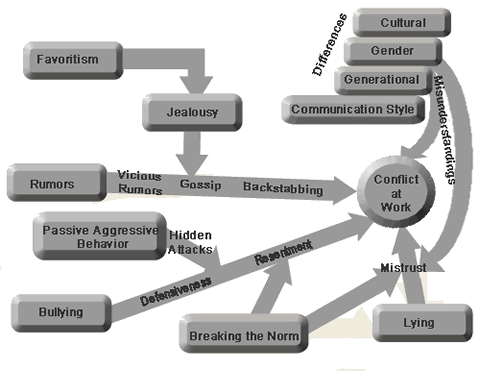- POPULAR ARTICLES
- Thank You Words
- Retirement Wishes
- Face to Face
Managing Conflict in the Workplace
Conflict in the workplace needs to be managed early on, before it affects productivity and morale.
Workplace conflict is caused by either interpersonal employee differences or organizational problems. Or a mix of both.
The supervisor or manager needs to discern what type of conflict he/she is dealing with before coming up with a resolution strategy.
Employee Conflict
When employees having problems relating and working together, the best course of action is to talk with each employee to find out the cause of the problems.While it takes two (or more) to create communication problems, it takes only one to start it. A supervisor dealing with employee communication problems needs to find out what's (1) triggering the problems and (2) what's keeping them alive, so he can deal with each one accordingly.
Team Conflict
A team experiencing communication problems is no longer effective working toward a common goal. Misalignment, mistrust, argumentative behavior, defensiveness are symptoms that the team is no longer functional. Addressing communication problems in a team is a bit more complex than addressing problems between two employees.A team that is having communication problems may be the bellwether for the organization as a whole. Or it could be just a bad mix of personalities. The manager has first to determine why the team is having problems and then apply corrective measures as appropriate.
Organizational Conflict
Conflict in the workplace can expand beyond employees and teams to include the entire organization.While uncommon, it can happen if the causes that lead to communication problems are left unmanaged.
Some people may start taking sides and an overall climate of distrust settles in. Others will disengage or leave the organization altogether. The organization has hit bottom.
Avoiding Conflict ... or Resolving It?
Sometimes we fool ourselves thinking we have peace in the organization, when all we have done is avoid conflict, not resolve it. We do have peace, but it's fake and superficial. Below the surface, undercurrents of hostility run deep. But people treat each other nicely.
Failing to address interpersonal problems leads to loss of productivity and low morale. Resentment builds and once it's in place, it's hard to get rid of it. Resentment can grow to a point of no return. At that point, the only solution is for the person causing the resentment to leave or "be punished".
The chart below shows a diagram of the most common causes of communication problems at work.
As an example, when favoritism toward an employee takes place, others are likely to feel jealousy toward the favored employee. They may turn to spreading rumors or gossip about the employee which in turn may lead to conflict in the workplace.
Roads that may Lead to Conflict

Note: If you can't click on the image above, here are the related links:
While not all work favoritism leads to conflict, unmanaged favoritism will. While not all bullying leads to resentment, unmanaged bullying will. And so forth.
Managing conflict in the workplace
Conflict resolution takes place in two steps:
Step 1: Managing the conflict at hand now. When the problem is between two or three people, conflict management can be done by the immediate supervisor or manager of the people affected. When the manager is also part of the problem, an outside facilitator is invaluable.
It's shortsighted to avoid bringing in outsiders to help sort out differences. The potential losses due to employee communication problems are huge.
If the problem at hand has expanded to include a team or the organization as a whole, an outside facilitator is essential.
Step 2: Managing its roots to prevent future conflict. Please refer to the chart above to explore the possible causes of conflict at work and ideas on how to address them. You can click on the area of your interest to read more about it.
It's tempting to only do the first step in managing conflict: solving the communication problem at hand. But it's essential to take the time to complete the second step: dealing with the causes of the problem.
Restore the peace at work and keep it that way for all to enjoy.




